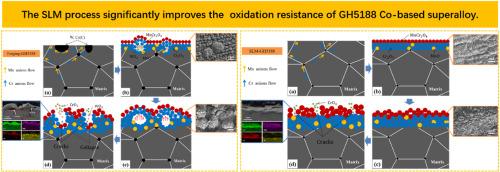High-temperature oxidation behavior of SLM-processed and forged GH5188 Co-based superalloy
引用次数: 0
Abstract
The high-temperature oxidation behavior of GH5188 cobalt-based superalloy, fabricated via selective laser melting (SLM) and forging, is investigated to elucidate the impact of additive manufacturing on oxidation resistance. SLM-processed samples exhibit a hierarchical microstructure with nanoscale carbides (∼80 nm) pinned at cellular boundaries (100 nm to micrometer scale), contrasting with the equiaxed grains (∼10 μm) and coarse W-rich M6C carbides (∼5 μm) in forged samples. After isothermal oxidation at 1000 °C and 1100 °C for 200 h, SLM samples show significantly lower mass gains compared to forged samples (69 % and 75 % of forged values), attributed to enhanced oxide scale adhesion and stability. Cyclic oxidation at 1000 °C for 50 cycles reveals stable mass gains in SLM samples (37 % of forged value) with minimal cracking, while forged samples suffer severe spallation due to volatile WO3 formation from coarse carbides. This study demonstrates that SLM's refined microstructure suppresses deleterious carbide decomposition, offering a novel strategy to enhance the oxidation resistance of Co-based superalloys for aerospace and high-temperature applications.

slm加工锻造GH5188钴基高温合金的高温氧化行为
研究了选择性激光熔化(SLM)和锻造制备的GH5188钴基高温合金的高温氧化行为,以阐明增材制造对抗氧化性能的影响。slm处理的样品显示出层次化的微观结构,纳米级碳化物(~ 80 nm)固定在细胞边界(100 nm至微米尺度),与锻造样品中的等轴晶粒(~ 10 μm)和粗富w M6C碳化物(~ 5 μm)形成对比。在1000°C和1100°C等温氧化200小时后,SLM样品的质量增益明显低于锻造样品(锻造值的69%和75%),这归因于增强的氧化垢附着力和稳定性。在1000°C下循环氧化50次,SLM样品的质量稳定增加(锻造值的37%),开裂最小,而锻造样品由于粗碳化物挥发性WO3形成而严重剥落。该研究表明,SLM的精细组织抑制了有害碳化物的分解,为提高航空航天和高温应用中co基高温合金的抗氧化性提供了一种新的策略。
本文章由计算机程序翻译,如有差异,请以英文原文为准。
求助全文
约1分钟内获得全文
求助全文

 求助内容:
求助内容: 应助结果提醒方式:
应助结果提醒方式:


